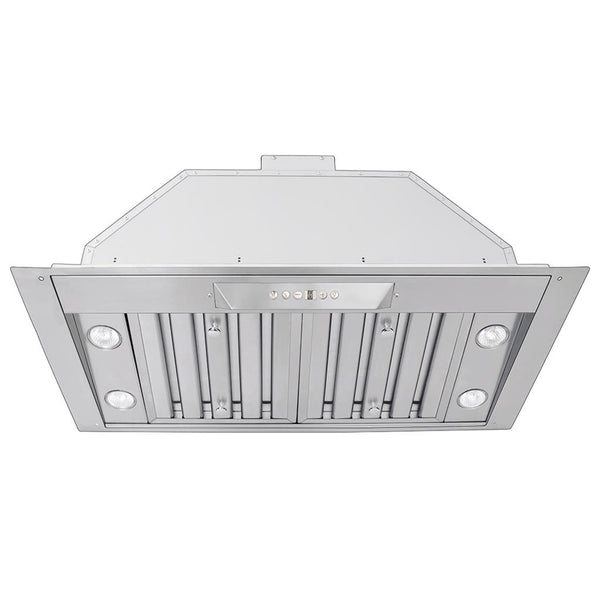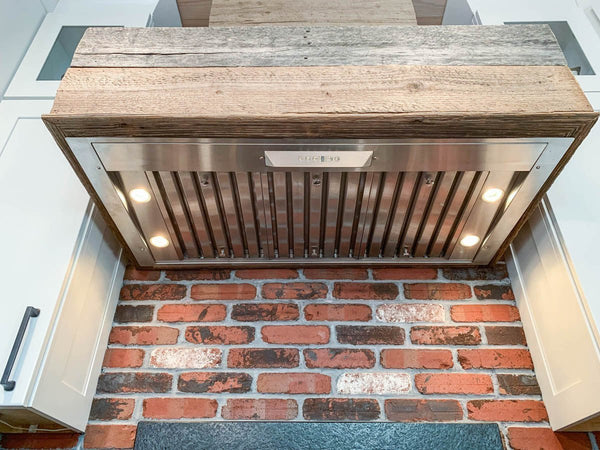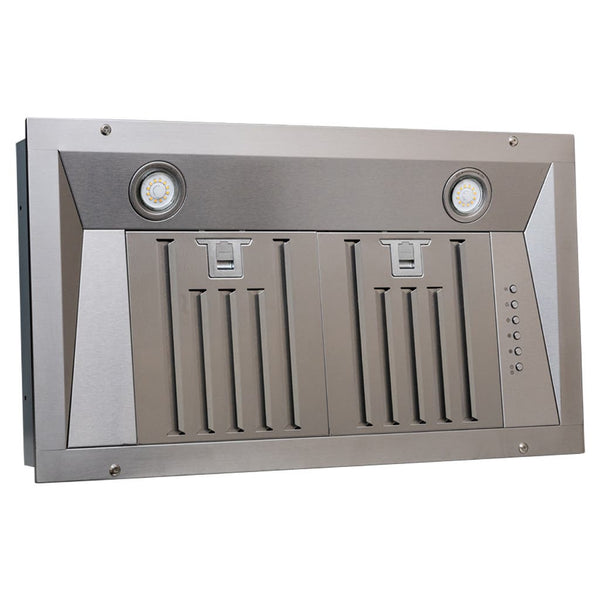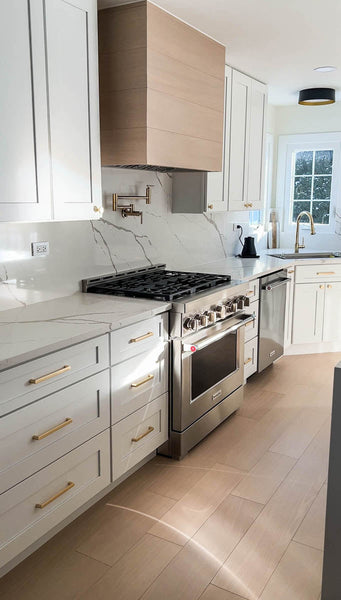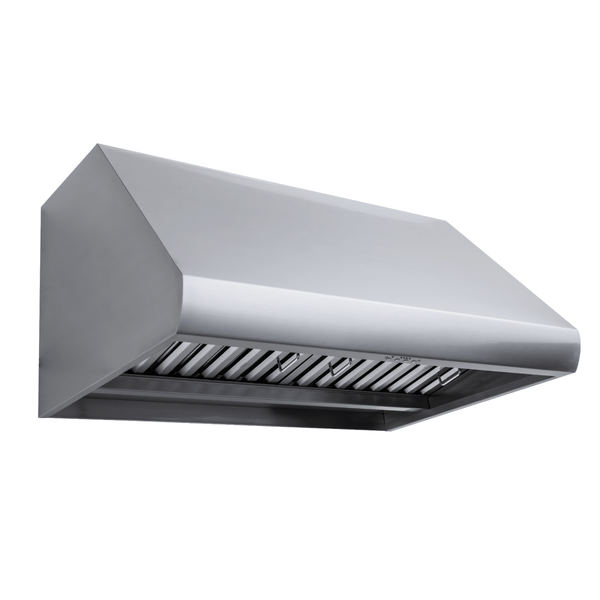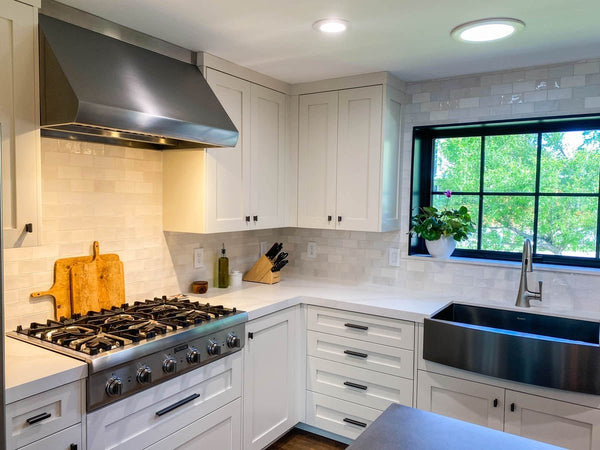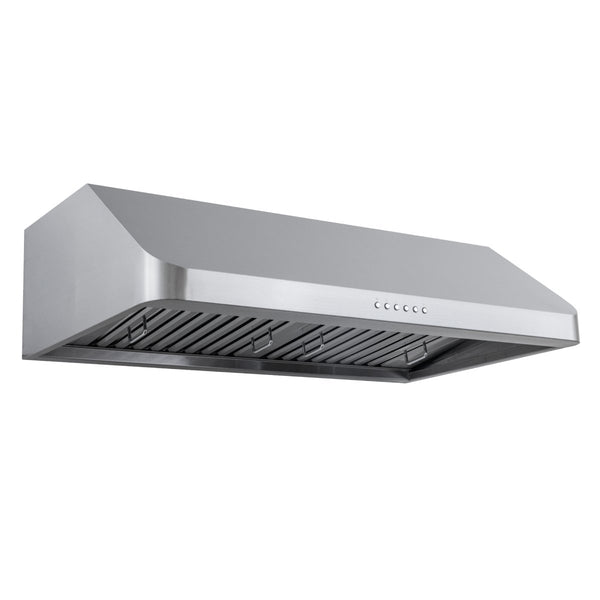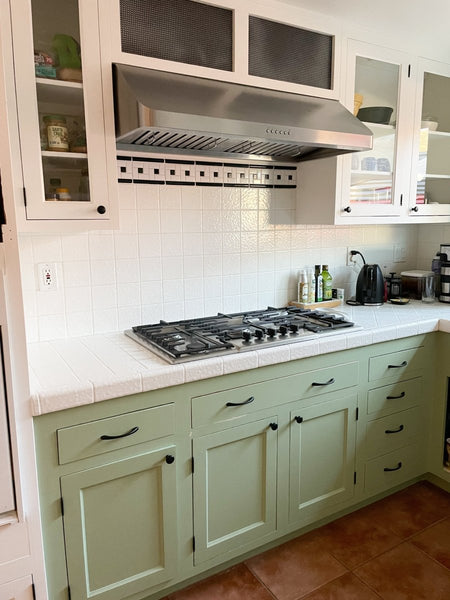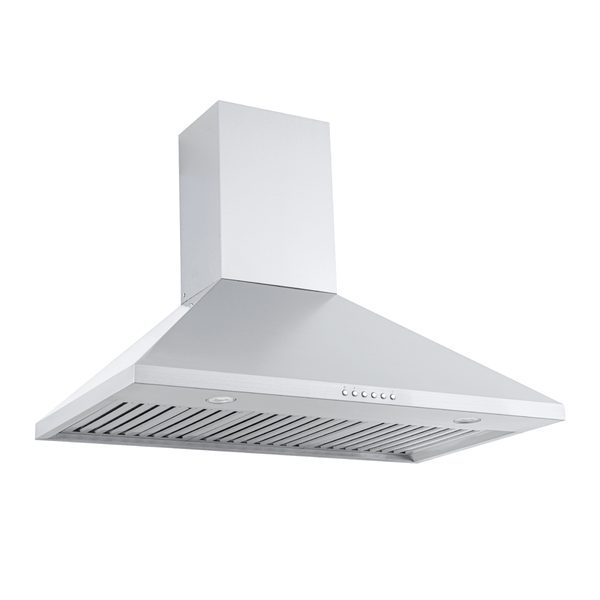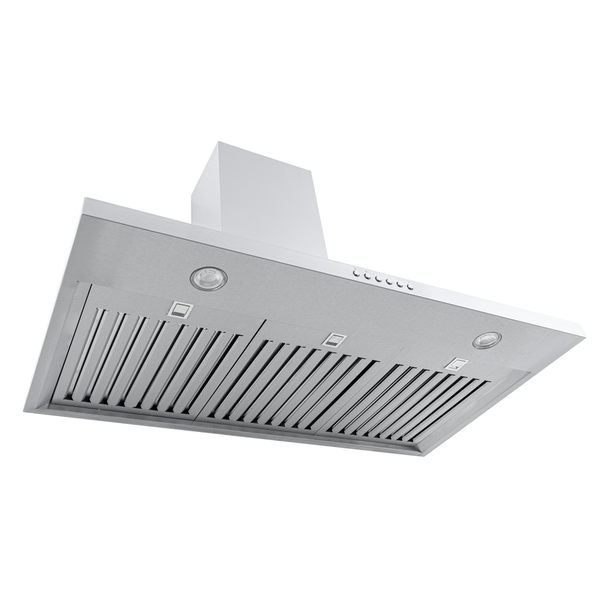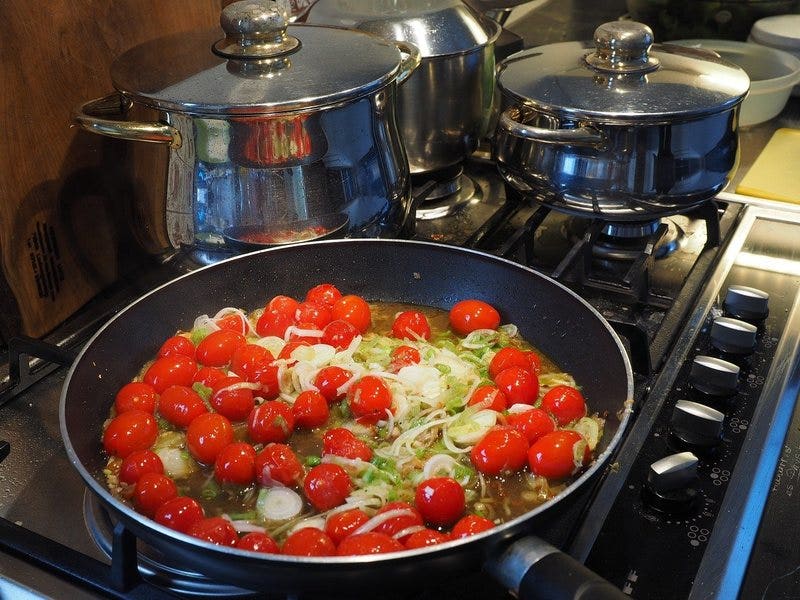Have you ever asked yourself: should I buy a wok or frying pan? Or what’s the difference between a wok and a frying pan?
When making the choice of what cookware is best for you, there’s so much to consider.
Is a wok better than a frying pan? Do I need both? What can I do with a wok but not a frying pan? What can I do with a frying pan but not a wok?
We’ll answer these questions and more as we help you make the best decision for you based on your cooking habits.
In short, a wok is designed for stir fry. It features tall, sloped sides and a small round bottom where your food does most of its cooking. Compared to a frying pan, a wok cooks food faster and hotter. So you have to constantly stir the food to make sure it doesn’t burn. A frying pan is more hands-off. You can start cooking your food, leave for a few minutes, and come back. Remember to use your kitchen hood vent when cooking to help eliminate order.
Check out the video below to learn about the science of a wok and how it works so well.
Frying Pan Pros
Ideal for cooking fragile cuts of meat
Frying pans are perfect to give fragile cuts of meat the texture you love. They aren’t too hot that the meat will break apart.
Doesn’t require constant babysitting
You don’t need to do a lot of tossing and flipping of your stir fry. Some supervision is needed of course. But compared to a wok you’re a little more hands-off.
Most pans feature a non-stick coating
The non-stick coating is great because it makes cleaning your frying pan so much easier. You also won’t have to struggle to pry your meat off the pan. If it’s not non-stick, your meat could easily burn as you struggle to flip it.
Work great on any stove
Gas, electric, induction…you name it. There’s a frying pan for every stove of every size.
Frying Pan Cons

Not dishwasher-safe
If your frying pan has a non-stick coating, this will slowly wear down in the dishwasher. Cast iron pans also do not react to heat and chemicals.
Long cook times compared to a wok
Frying pans have a wide bottom which takes longer to heat up and cook your meal compared to a round-bottomed wok.
Doesn’t retain heat as well as a wok
Frying pans have shallow walls so the heat escapes quickly.
Less room than a wok
Again, shallow walls mean you can’t pile up your stir fry as high as you might like.
Require more oil than a wok
A frying pan needs more oil or butter because you won’t be moving the food around as much as you would in a wok. So the oil needs to cover the entire bottom. Or at least the area where your food will sit.
The non-stick coating wears off over time
Non-stick coatings are heat resistant but not heatproof. Most non-stick coatings can’t handle above 450º to 500º. Over time, even at lower temperatures, the non-stick coating will slowly deteriorate.
Can’t be seasoned
A seasoned wok typically lasts longer than the non-stick coating on a frying pan.
Can’t cook as hot as a wok
Again, the non-stick coating will wear down. Once it does you can’t reapply it like you could reseason a wok.
Wok Pros
Short cook time
The wok itself heats up to about 400º once you add food. When working with such high heat, your food will cook in no time.
Fits a lot of food
A wok features high sloped walls that allow you to fit more food than a frying pan.
Versatile
A wok is great for stir-frying, shallow frying, deep frying, braising, steaming, and many other techniques.
Several different types
Most woks today are made with carbon steel, stainless steel, or cast iron.
Natural non-stick coating
A natural non-stick coating develops over time after seasoning the wok.
Usable in most kitchens
Woks are great over an electric, gas, or induction stove. Round bottomed woks are best over gas stovetops, while flat bottomed woks work well over electric and induction stoves.
Food cooks evenly
In wok cooking, your food is always moving around. It doesn’t make contact with the wok for the entire cook time. This helps the food cook evenly at high heat.
Require little oil
Because you’re tossing and flipping food around, it will all make contact with the oil that pools in the bottom of the pan. So you don’t need to coat the entire wok with oil. Just pool 1-2 tablespoons in the bottom and you’re set.
Wok Cons
Acidic food will wear the wok down
Acidic food like citrus fruits will slowly wear away at the seasoning of your wok. Yes, a seasoned wok is more durable than a non-stick coating. But the seasoning will eventually deteriorate.
Easy to burn food if you’re not careful
Wok cooking requires a lot of supervision. The food has to keep moving to ensure you don’t burn it.
Woks heat up and cool down quickly
Woks are quite thin compared to other types of cookware. They heat up incredibly quickly. When removed from heat, they cool down quite fast as well. Keep this in mind when cooking so you cook your food properly.
On an electric stove, you can set up two burners, one at low heat and one at high heat. When the food is nearly done, you can swap to the low heat burner if needed. You can also start preparing another dish on the low heat burner after you’re done stir-frying. For example, you could sauté some vegetables.
Requires seasoning
To cook with a wok properly, you must season it. This takes some time and a little research but it has to be done to get the most out of your wok. Otherwise, all your food will stick to the bottom, making stir-frying nearly impossible.
Not ideal with electric or induction stoves (but still viable)
Traditional round-bottomed woks are not ideal for electric or induction stoves since they sit on a wok ring. The bottom is therefore far away from the heating element, which makes cooking difficult. You’ll have to go with a flat bottomed wok.
Even then, keep in mind that electric stoves do not get as hot as gas stoves. So you might have to wait a while for your wok to preheat. In contrast, induction stoves will heat up quickly.
May need to invest in additional accessories such as a wok ring, lid, or spatula
Round bottomed woks require wok rings. You’ll also want a lid if you braise meats or deep fry. A spatula is also a great accessory to make cooking easier.
Must exercise extreme caution since you’re working with high heat
Be careful tossing and flipping your food when working with a wok. The pan and handle will be incredibly hot so be careful!
The wok itself can reach up to 700º before you put food in and anywhere from 350º to 400º degrees after you add food. Sometimes your wok will be hotter depending on the smoke point of your oil.

Round vs. Flat Bottomed Woks
You have two choices for your wok: round bottom or flat bottom. The ideal choice is a round bottom wok if you own a gas stove. They distribute heat evenly and they are easy to maneuver when stir-frying. A round bottom wok will get hotter more quickly than a flat bottom wok because the flat bottom has a larger surface area.
Round bottomed woks require a wok ring to stabilize the pan, so they are not ideal for electric or induction cooktops (see also 'Do Induction Cooktops Scratch Easily?'). You also run the risk of scratching your glass stove top if you use a round-bottomed wok with a ring.
Flat bottomed woks do not require a wok ring so they are the best option for an electric stove. The entire bottom makes contact with the heating element on your stove. Although they take longer to heat up, flat bottomed woks are more stable than round-bottomed woks.
The bottom is wider than round-bottomed woks so you can cook large cuts of meat like chicken breasts or steaks.
What materials are woks made of? What about frying pans?
Most woks are made of carbon steel, a lightweight and highly conductive material. You’ll also find stainless steel or cast iron woks. In contrast, most frying pans are aluminum and stainless steel. But you can also find carbon steel and cast iron frying pans.
You might want a wok if…
- You like to stay around the kitchen
- You enjoy the natural flavor and non-stick properties of a seasoned wok
- You love to braise, fry, deep fry, steam, sauté, and much more
- You like to load up the pan (but don’t go overboard)
- You want to keep the amount of oil down
- Your goal is to cook food as evenly as possible
You might want a frying pan if…
- You’re more hands-off in the kitchen
- You don’t want to worry about seasoning a wok
- You want to sear or fry large cuts of meat that won’t fit in a wok
- You want to keep the kitchen a little cleaner
- You love to cook soft foods. They would fall apart exposed to the high heat of a wok
Is a wok better than a frying pan?
Compared to a frying pan, a wok has a shorter cook time, fits more food, and requires less oil. Unlike a frying pan, you can season a wok which helps it develop a natural non-stick coating. Woks are best with gas stoves. Since they cook at such high heat, it’s easy to burn food if you don’t keep the wok moving.
Can a wok be used as a frying pan?
Yes. You won’t have as much room in the bottom compared to a frying pan. But if you’re stir-frying you can fit a lot more food compared to a frying pan. Don’t put as much oil in your wok. As you move the food around it will absorb the oil that pools in the bottom.
What are the disadvantages of a wok?
In short, wok cooking takes practice. It’s incredibly easy to burn your food and overcrowd the pan if you’re not careful. A wok heats up and cools down quickly which means it can be difficult to cook food evenly if you are not experienced.
Can I fry my chicken in a wok?
Yes, you can fry chicken in a wok. Small pieces of chicken like chicken nuggets are best fried in a wok. Large cuts of meat like chicken breasts will not fit so you will have to cut them into smaller pieces.
What are the five benefits of stir-frying?
Colorful meals
Stir fry often features a host of colorful vegetables and seasonings, making for a great presentation.
Fast cook time
Most of the work in stir-frying is done before you cook: gathering the ingredients. Stir-frying itself often takes 10 minutes or less.
Nutritious meals
Because stir fry takes little time to cook, the food retains a lot of its nutrients. The less oil you use, the healthier. If you cook with a wok, you can use less oil compared to a frying pan.
Can cook in batches
If you want to cook for a crowd, with stir fry you can! Just cook the vegetables in batches. It’ll only take 10 minutes at a time if that.
Cost-effective
Stir-fry typically has some meat, but it’s not too heavy on protein. Most of your stir fry will be vegetables and maybe some noodles too.
Is it bad to eat stir-fry every day?
That depends on how you make your stir-fry. If you eat stir-fry every day, make sure that it’s well balanced with protein, carbs, and vegetables. Don’t go overboard on the oil to keep the calories down.
What are three tools needed for stir-frying?
To get started stir-frying, invest in a wok, wok spatula, and wok ladle. You also will need a wok ring if you go with a round-bottomed wok.
What vessel is used in stir-frying?
A wok is best for stir-frying. You can choose between a round-bottomed wok with a wok ring or a flat bottomed wok. Flat bottomed woks are best for electric or induction stoves. The bottom is wide and flat so it makes contact with the heating element.
Carbon steel is a durable and lightweight option for woks. Stainless steel is durable too. Cast iron is heavy although it retains heat incredibly well.
Thanks for reading our complete article on woks vs. frying pans. Have you decided which one is right for you? Remember, you don’t have to choose. It may be best for you to invest in both! One is not better than the other, but they serve different purposes.
Look over the pros and cons again and think about your cooking habits. Which pan sounds like the best fit for you?
We hope you make the right choice! Have fun cooking!
As an Amazon Associate, we may earn from qualifying links.
Is a wok better than a frying pan?
Can a wok be used as a frying pan?
What are the disadvantages of a wok?
Can I fry my chicken in a wok?
What are the five benefits of stir-frying?
Stir fry often features a host of colorful vegetables and seasonings, making for a great presentation.
Fast cook time
Most of the work in stir-frying is done before you cook: gathering the ingredients. Stir-frying itself often takes 10 minutes or less.
Nutritious meals
Because stir fry takes little time to cook, the food retains a lot of its nutrients. The less oil you use, the healthier. If you cook with a wok, you can use less oil compared to a frying pan.
Can cook in batches
If you want to cook for a crowd, with stir fry you can! Just cook the vegetables in batches. It’ll only take 10 minutes at a time if that.
Cost-effective
Stir-fry typically has some meat, but it’s not too heavy on protein. Most of your stir fry will be vegetables and maybe some noodles too.
